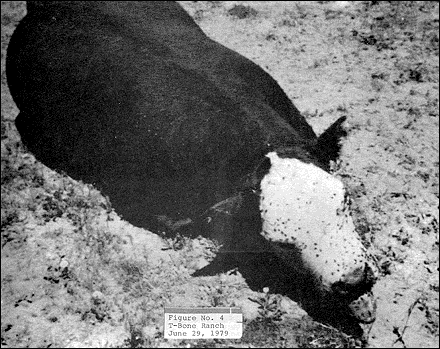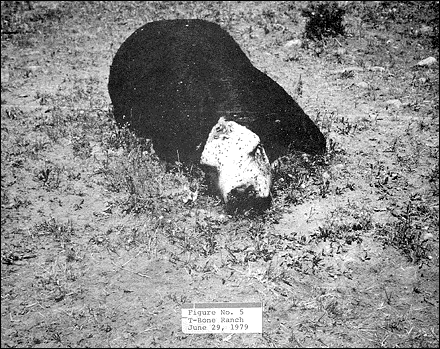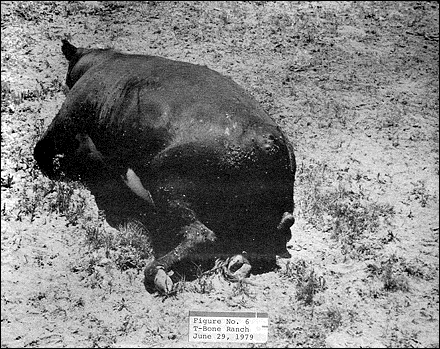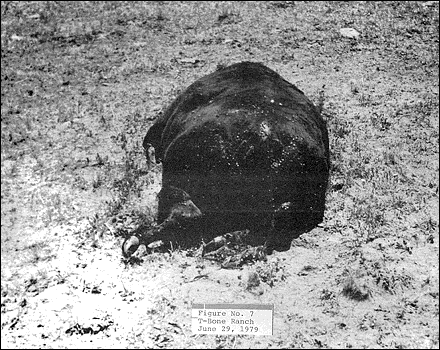On June 29 I was horseback riding in the T-Bone Ranch area of the Carson National Forest. Accompanying me were Forest Supervisor Jack Crellin, Dr. Howard Smith of Roswell, and several other people, including some forest employees.
During the ride we discovered six dead cows, all of which had recently died from larkspur poisoning. We noted that larkspur was abundant in the area. In fact, it had plagued a good portion of northern New Mexico that spring because of an unusually heavy rainfall. We observed that the carcasses were covered with bird defecation. In addition, coyotes were seen in the area as we rode through.
Photographs of one carcass were taken at this time by Dr. Smith. Then at my request, Forester Bill Wright returned to this same isolated spot three days later (July 2) and rephotographed the same carcass. Some very interesting observations can be made from the following four photographs:

Figure No. 4 is a photograph taken June 29. It clearly shows that the animal died with its tongue protruding and ears intact. The protruding tongue is important, for during this investigation I have encountered statements, attributed to certain unidentified veterinarians, that no animal could open the mouth of a carcass to remove the tongue. But as this photograph shows, the explanation is really quite simple, since it is not unusual for an animal to die with its tongue protruding, especially if it has been poisoned. This photograph also shows a circular spot to the left of the mouth, which appeared to be blood and other body fluids that had drained from the mouth.

Figure No. 5 taken July 2 shows the same animal, but as you can see, both the tongue and right ear are missing. Also note that the spot is no longer visible a fact that could give rise to the statement that no blood is found at the scene of a mutilation. It is my observation that the amount of visible evidence present and the amount of damage done greatly depend upon how much time has elapsed before the carcass is discovered, and which animals have had access to it.

Figure No. 6 taken June 29 of the same animal shows the anus area beginning to puff out as the result of the formation of gasses inside the carcass and the relaxation of muscles as a result of death. This area as you can see, is now a readily accessible target for scavengers.

Figure No. 7 taken July 2 of the same animal reveals a circle beginning to form at the anus area. This portion of the animal is now being decimated by nothing more than the common blowfly. However, this effect is readily shaping up to what could have later been described as a "cored rectum."
In conclusion, this case was especially interesting and important since it resulted in a series of photographs that provide a "before and after" comparison -- a visual proof of scavenger-induced damage. This is another example, not of some bizarre intrigue, but of nature's ecologists performing their daily tasks on animals who had obviously died from larkspur poisoning. As the supervisor of the Carson National Forest points out, anytime northern New Mexico has a spring characterized by an unusual large amount of rain, there will be a potential larkspur problem in that part of the state.
Larkspur, however, is just one of more than one hundred plant species in New Mexico that are poisonous to livestock. Information on these potentially dangerous plants is provided in a pamphlet published by the Cooperative Extension Service of New Mexico State University, from which the following excerpt is taken.
Most poisonous plants on New Mexico ranges are native. Usually, livestock graze them only when more desirable species are scarce or when watering facilities are not adequate. A lack of minerals such as salt or phosphorus may cause animals to graze plants they would not usually eat. Some poisonous plants such as lupines, locos, and larkspur 'green up' early, and animals craving green feed may graze these poisonous plants to satisfy their need. A few poisonous species, like these, are relatively palatable (Gay and Dwyer 1967: 1).